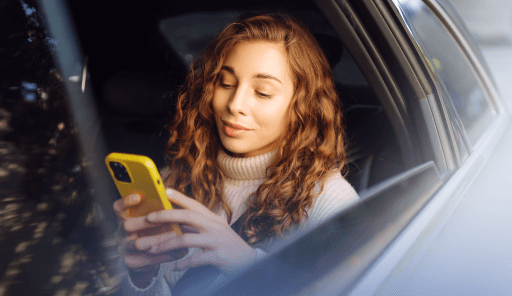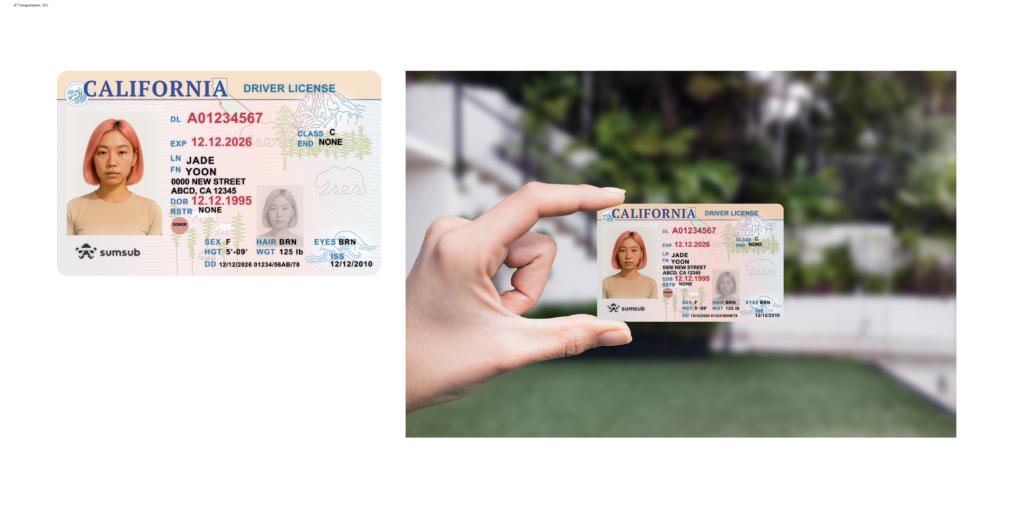- Jun 20, 2025
- 9 min read
Driver’s License Verification in Mobility: How Platforms Stay Compliant & Safe
Learn how driver’s licenses are verified and why verification is important for compliance and security in 2025.

Digital platforms have revolutionized how we access transportation. From carsharing to e-scooters, the convenience is undeniable. The number of carsharing users worldwide reached approximately 84.8 million at the end of 2024 and is projected to hit 138 million users by 2029. However, this convenience and growth come with their own set of challenges, particularly concerning fraud and safety.
In the auto lending sector alone, fraud losses climbed to $9.2 billion during 2024, up 16.5% over 2023 losses—and these numbers will only get higher without proper, robust verification systems in place.
Driver’s license verification is therefore a critical tool for the mobility industry. By making sure that users are who they claim to be, platforms can prevent unauthorized access, reduce identity fraud, and maintain compliance with legal standards.
Read through this article for more on the importance of driver’s license verification, its implementation, and the technologies that make it possible.
What is driver’s license verification?
Driver’s license verification is the process of confirming that a license is authentic, valid, and matches the identity of the person submitting it. In short, it’s about showing that someone who claims to be a licensed driver actually is one.
For mobility and transportation platforms, from carsharing to ride-hailing apps, this step isn’t just a box to tick. It’s a frontline defense against fraud, underage use, and regulatory violations. A license may look real to the naked eye, but that doesn’t mean it’s legitimate. In many fraud schemes, synthetic or stolen identities are paired with forged documents to slip past basic checks. Driver’s license verification helps platforms weed out such attempts before they lead to costly incidents.
Suggested read: Trust on the Move: Fraud Prevention and Verification in the Mobility Industry (2025)
Where is driver’s license verification required in mobility?
According to estimates, in 2025, about 1.644 billion people worldwide hold a driver’s license, though the number could be closer to 2 billion.
The growing number of people obtaining driver’s licenses directly increases the need for driver’s license verification. As the mobility industry becomes increasingly diverse and digital-first, more services, many of which operate without human oversight, need to verify drivers before handing over the keys (literally or virtually).
Here’s how driving license validation is done in different mobility sectors:
🚗 Carsharing platforms
Companies like Getaround, Turo, and HoppyGo let users book vehicles through apps, often with zero human interaction. In this environment, verifying a valid driver’s license becomes essential for onboarding. Without it, a person could book and drive away with a vehicle without ever proving they’re legally permitted to operate it. Verification helps prevent both fraud and liability for platform providers.
🚕 Ride-hailing and peer-to-peer services
Whether it’s a full-time driver on Uber or a one-off user renting a car via a peer-to-peer model, platforms need to make sure the person behind the wheel is legit. For drivers, that means verifying license authenticity before they’re even allowed on the road. For users, especially in P2P models, verifying the license means mutual trust between parties.
🛵 Moped, scooter, and e-bike rentals
While not all micro-mobility services require a driver’s license, some do—especially mopeds and speed-limit electric vehicles. For example, mopeds in many EU countries and in US states like California require a special category or class of license. In these cases, platforms must verify that users meet the legal criteria before letting them ride.
🚙 Traditional car rentals
Car rental companies have required physical license checks at the counter for a long time. With the rise of self-service rental stations and digital onboarding, many are adopting remote verification technologies. This allows users to unlock vehicles with their phone, after passing license and identity checks in advance.
Take the example of Avis: this huge car rental company needed a reliable way to verify driver licenses digitally without forcing users to go to a rental desk, once they launched their services in Estonia. Using Sumsub’s verification, Avis cut onboarding time to under 2 minutes and reduced fraud risks while keeping full compliance with EU data protection and road safety regulations.
🛻 Commercial and corporate fleets
Fleet management solutions also rely on license verification, especially when onboarding new drivers in logistics or company car programs. Checking whether each employee has the correct class of license and that it hasn’t expired (or been suspended) is crucial for compliance and insurance coverage.
Why do mobility platforms require driver’s license checks?
Driver’s license verification is about protecting users, assets, and brand reputation in an industry that’s becoming more digital and more vulnerable to fraud with every passing year. There are a few reasons why mobility platforms rely on these checks.
- Fraud prevention. Mobility platforms are frequent targets for identity fraud, synthetic identities, and account takeovers. Without proper license checks, fraudsters can easily register under fake names, steal vehicles, and vanish—leaving the company to absorb the losses.
- Account sharing. Account sharing is generally prohibited across mobility sectors such as ride-hailing, car and scooter sharing, and delivery platforms. These services require verified identities to ensure user safety, legal compliance, and proper liability coverage. Sharing an account undermines these safeguards, complicates accountability in case of accidents or violations, and can void insurance protections. As a result, most platforms explicitly forbid account sharing in their terms of service and treat it as a significant fraud risk.
- Safety and liability. Letting an unlicensed or suspended driver access a vehicle can have serious consequences—not just for the user but for the platform’s legal and financial standing. Among other problems, if an accident happens, and the driver wasn’t properly verified, insurance coverage may be void, and the platform may be held liable.
- Legal compliance. In most countries, allowing someone to drive without verifying their license status is a direct violation of transportation laws. For example, in the EU, Know Your Customer (KYC) and driving eligibility rules apply to almost all forms of transportation, including micromobility.
- Age verification. This is required to check if the driver is old enough to legally drive.
- User trust. When users know that everyone goes through a real identity check, they’re more likely to feel safe using the service. This is particularly important for peer-to-peer platforms, where one user is handing over the keys to another.
- Efficiency. Manual license checks slow things down. Automated verification systems let users onboard in minutes, at any time, from anywhere, without the need for in-person approvals or staff oversight.
How does driver’s license verification work?
The process of verifying a driver’s license may seem straightforward—snap a photo and you’re done—but under the hood, it involves multiple layers of checks designed to confirm identity, detect fraud, and ensure compliance. Today’s leading mobility platforms rely on sophisticated, AI-powered workflows to handle this process in real time, in order to keep compliant and improve the experience for everyone.

So, how does this verification actually work? Let’s break it down:
- Proof of identity and license check. The user begins by uploading a photo of their driver’s license during registration. This can be done by taking a picture through the app or uploading a scan. Usually, this step requires the drivers to provide an ID as well as a license for checking.
- Optical Character Recognition (OCR) and Data Extraction. OCR technology reads the text from the image, pulling out key fields such as name, license number, expiration date, issuing country, and document type. This step must handle different layouts and languages depending on where the license was issued.
- Authenticity checks. Next, the license is screened for signs of forgery. The system looks for specific document templates, holograms, fonts, and layout patterns that match government-issued standards.
- Liveness and face matching. To make sure the license actually belongs to the person holding it, the user is asked to take a selfie or perform a liveness check. The system compares the face on the license to the live image, checking if it’s a real person (not a photo or video spoof) and that both faces match.
- Approval or rejection. If all checks pass, the user is approved and can access the vehicle or service. If any red flags are detected, such as an expired or tampered license, the user is either rejected or directed to a manual review process.
What are the common challenges in license verification?
While digital license verification has come a long way in recent years, it’s not foolproof. Mobility platforms still face a number of technical, regulatory, and fraud-related challenges that can complicate the process. Here are some of the most common issues:
Fake and altered licenses
One of the biggest challenges is the use of counterfeit or tampered documents. Sales of fake licenses can reach up to $500 million annually. Some of these fakes pass the eye test but break down under deeper scrutiny, especially if they use incorrect fonts, missing holograms, or mismatched data. Detecting these anomalies requires a verification solution that includes both document forensic checks and machine learning trained on global license templates.
Poor image quality and bad lighting
A blurry or poorly lit photo can completely derail the verification process. Users often take license pictures in dim environments or with reflections obscuring key features like watermarks or barcodes. This makes it difficult for OCR and AI systems to extract and analyze information accurately. Luckily, non-doc verification allows users to submit only their ID number in the jurisdictions where it’s applicable, if the image quality is bad, so that they can get verified quickly and easily.
Regional and format variations
There’s no universal standard for driver’s licenses. Countries, and even states or provinces within countries, have different formats, fields, languages, and security features. For example, a US license might have a magnetic stripe, while a German one might have a MRZ or NFC chip. Verification systems need to recognize and process all of these different designs.
Suggested read: MRZ Code—How Does It Work?
Data privacy
Collecting and storing driver’s license data comes with major compliance obligations, especially under laws like the GDPR in Europe or the CCPA in California. Platforms must ensure that sensitive personal data is encrypted, stored only as long as necessary, and never used beyond its intended purpose. Failing to comply with these rules can result in hefty fines or reputational damage.
Manual review bottlenecks
Even with automation, some cases still require human oversight, especially when a document is flagged as suspicious. However, manual review takes time, in cases such as teams being small or operating across time zones. Slow review processes can frustrate users, delay access to services, and lead to customer churn. Robust verification systems can improve this experience and make the process smoother and faster.
What technologies are used for digital license verification?
Driver’s license verification relies on a mix of cutting-edge technologies working together to be accurate, secure, and compliant. Here are the core components of modern license checks:
Optical Character Recognition (OCR)
OCR is the first line of defense in digital license verification. It scans the license image and converts printed text into machine-readable data. OCR extracts critical fields such as name, date of birth, license number, and expiration date. High-performance OCR systems must be trained on global license formats to handle different fonts, languages, and layouts—since a license from Germany looks nothing like one from Japan or the US.
AI-powered template & format matching
AI models trained on thousands of real documents can detect inconsistencies that signal a fake. These systems check the layout, embedded features like barcodes or MRZ zones, and even tiny font details. If a fraudulent license is missing a microprint or security watermark, AI will likely catch it.
Liveness detection
Liveness detection makes sure that the selfie being taken is of a real person. Active liveness might ask the user to blink, smile, or turn their head. Passive liveness works in the background, using camera feed data to detect texture, depth, and light reflection on skin.
Suggested read: Liveness Detection: A Complete Guide for Fraud Prevention and Compliance in 2025
NFC chip scanning (where available)
Some newer driver’s licenses—especially in the EU—have embedded NFC (near-field communication) chips that store encrypted personal data. When supported, platforms can prompt users to scan their license with their smartphone, just like an e-passport.
Database and watchlist checks
Although not tied to the license document itself, many platforms combine license verification with database lookups. These can include:
- Government-issued license registries (where accessible)
- Traffic violation or revocation databases
Best practices for driver verification in shared mobility
How a mobility platform verifies its users can make or break the onboarding experience—and ultimately determine whether users stay with the platform or churn. To avoid drop-offs while keeping the system safe and compliant, there are some practices that transportation companies should build into their workflows:
- Include smart fallback flows. Not every user will pass verification on the first try. Maybe they uploaded a blurry photo, or their ID had glare from the sunroof. Smart platforms don’t outright reject these users—they offer fallback flows. For example, Ridenow increased the pass rates by 25% since integrating Sumsub’s verification.
- Apply region-specific age and license rules. Not all countries or vehicles follow the same rules. For example, the legal driving age is 18 in most EU countries, but 16 in many US states, with some states even pushing to let 15-year-olds drive. Platforms need to build logic that takes these variations into account and only allows access to users who meet the local requirements.
- Minimal data retention. Only collect what you need, and keep it only for as long as necessary. Mobility platforms should store only essential license data and securely delete any biometric data or facial recognition inputs after verification is complete, unless otherwise required by law.
- Use multi-factor identity checks. Don’t rely on just the license. Combine license verification with other layers, like phone number validation, liveness checks, and selfie verification, to reduce the chances of account takeovers or stolen credentials being misused.
- Continuous monitoring. Verification shouldn’t stop after registration. Consider setting up automated verification for users who haven’t accessed the service in over a year or when suspicious behavior is detected, such as accessing the platform from a new country or device. Reverification is also useful for checking if a driver’s license is valid or expired.
Benefits of automated license verification
Manual license checks can’t keep up with the speed and scale of today’s shared mobility platforms. Automated license verification, on the other hand, allows companies to onboard users in seconds, not hours, while dramatically reducing fraud, human error, and operational costs.
With the help of AI, biometric matching, and document authentication, automation makes sure the process is accurate and compliant without burdening the user. It’s the difference between waiting in line at a rental counter and unlocking a car with your phone in two minutes.
Here’s how manual and automated verification stack up:
| Feature | Manual verification | Automated verification |
| Speed | Several minutes to hours | Seconds (often under 1 minute) |
| Scalability | Limited by staff availability | Instantly handles high volumes 24/7 |
| Fraud detection | Prone to human error and fatigue | Uses AI to spot fakes, alterations, and deepfakes |
| User experience | Requires waiting, often with friction | Fast, mobile-first, self-service onboarding |
| Cost | High (requires trained staff) | Lower (minimal manual review needed) |
| Global document support | Often limited to local or known templates | Supports hundreds of formats and languages |
| Compliance | Paper-based or inconsistent | Fully logged and regulation-ready |
| Liveness and face matching | Manual ID matching is often unreliable | Biometric verification prevents impersonation |
-
How do carsharing platforms verify a driver’s license?
Carsharing platforms use digital verification tools to scan and analyze the license, extract key data, confirm authenticity, and match it to a live selfie or biometric input.
-
Why is driver’s license verification important for scooter and bike sharing?
Driver’s license verification ensures users meet legal age and licensing requirements for certain vehicle types and helps prevent fraud or misuse of shared accounts.
-
Can driver’s licenses be verified instantly using an app?
Yes, most modern mobility apps can verify licenses in seconds using AI, OCR, and biometric matching, all within a seamless mobile flow.
-
What technologies are used to detect fake licenses?
AI-driven tools analyze document layout, fonts, and security features, while liveness detection and face matching help spot identity fraud.
-
How does digital license verification improve user onboarding and safety?
Digital license verification shortens the signup process and ensures only authorized, licensed users gain access—protecting both the platform and its users.




